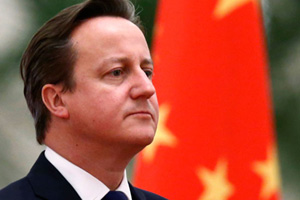
Green bonds take on a Chinese tinge
Comments Print Mail Large Medium Small
|
The issue of the yuan-denominated green bond in London is regarded as another step in the internationalization of the currency. Provided to China Daily |
Currency gains lift as yuan-denominated instrument gives it a new set of wings
The International Finance Corporation has issued the first ever yuan-denominated green bond in London, setting a new trend on the back of growing offshore yuan activities in the city.
Green bonds are a relatively new but rapidly growing asset class, with proceeds from the financing being channeled into climate change solutions. Most green bonds are denominated in US dollars and euros, making IFC's yuan green bond significant.
Benjamin Powell, IFC's head of funding, says: "Until last year you would only see green bonds in dollars, but as more issuers are adopting the green bonds initiative, you start to see that tie in with interest from investors in other jurisdictions.
"A lot of funds are just establishing social responsible investment funds in their renminbi portfolios, so we are a step ahead in the currency move."
IFC, which is a member of the World Bank Group, has many lending activities in China, where funds are channeled to projects that deal with climate change concerns.
Over time the proceeds of the yuan green bond will be allocated to specific projects, which could be in China or other emerging markets. Powell says the proceeds are now converted to US dollars to avoid exchange and currency risks.
The bond is listed on the London Stock Exchange, and the three-year green bond is priced with a yield of 2 percent. HSBC is the sole lead manager for the bond. Criteria for the use of IFC green bond proceeds are certified by Cicero, a research center associated with the University of Oslo.
Green bonds are a relatively new asset class, started in 2008 when the World Bank's environment department issued the first. Proceeds were small, in the tens of millions, and there were few investors.
But the bonds have picked up pace. In February last year IFC raised a record $1 billion (736 million euros) green bond, andi n November the French energy group EDF raised 1.4 billion euros, the first euro-denominated green bond from a large company.
This marked the point at which corporate issuers took over from international financial institutions as the main issuers of such bonds, and the EDF bond was followed by bonds from Toyota and Unilever.
Chris Jones, global head of the local currency syndicate at HSBC, says green bonds appeal to funds that specialize or deal exclusively in socially responsible investment funds, which are prominent in London and other European cities, he says.

Jones says the bond has attracted many investors in Europe and Asia, which is in line with IFC's aim of international distribution. Sixty-three percent of the accounts were Asian and the rest European.
Funds that have exclusive or segregated spending allocated to green or socially responsible investment assets may be preferable to many investors such as charitable or religious foundations, he says.
"However, many green funds or socially responsible investment funds are being set up which may be marketed to the institutional and retail investor alike, which is both a marketing angle and filling a gap in the product market where investor demand is increasing."
Jones says IFC expects to be an increasingly relevant borrower in the yuan market, both demonstrated by this green yuan bond and the establishment of a conventional 2 billion yuan ($321 million; 236 million euros)-denominated benchmark bond issued in London earlier this year.
One benefit of having the bond listed on the London Stock Exchange is that it can be available for trade by international investors in their time zone, he says.
Listing a bond on a recognized exchange ensures that the respective asset complies with EU investment rules and can then be considered for investment by a broader range of investors.
"We encourage transparency and adherence to the highest possible green bond criteria," Jones says. "It may cause problems for SRI investors if the funds raised are not clearly segregated for the benefit of financing green projects. Some borrowers issue green bonds with only a 'best efforts' intention to use the proceeds for green causes, where other organizations adhere to similarly high standards as the IFC and have their green lending criteria audited."
Jones says the yuan-denominated green bond issued by IFC will have proceeds put into a segregated account to ensure compliance with their high level of green bond criteria relating to use of proceeds.
Jones says the internationalization of the yuan and the development of the green bond asset class are two key drivers for HSBC, and it has worked hard with IFC to bring the inaugural offshore yuan bond to market.
"We ensure that we maximize distribution into socially responsible investment focused accounts, and we check investors' SRI credentials."
Powell says IFC wanted to issue the bond in London partly because it wants to support London's drive to become an important offshore yuan hub in Europe, but commercial return is another motive.
"We support the internationalization of the yuan in London. We also see the London offshore yuan market to be a good market to raise funds."
For the previous dollar-denominated green bonds that IFC issued, he says, yield is much lower than the 2 percent yield of the yuan bond, but because demand for the yuan is high in the international currency market, issuing the green bond in yuan gave IFC reasonable returns.
Although IFC holds the proceeds in dollars, it has swap arrangements with a few banks to access yuan if it needs to use the fund to finance projects in China.
At present the IFC yuan green bond can only tap into offshore yuan, but Powell says he hopes there will be opportunities for IFC to issue bonds in China's onshore yuan market.
China has no green bond market, and some experts in the country have said such a market could help China to cope with its energy financing needs.
Under China's 12th Five-Year Plan, the country has ambitious plans to improve energy intensity, grow environmental industries and reduce environmental stress. This will require the mobilization of huge amounts of capital.
Last August the State Council announced plans to grow a corporate green bonds market in China as part of meeting the objectives of the 12th Five-Year Plan (2011-15).
The International Institute for Sustainable Development published a report in February examining the prospects of developing a green bond market in China by allowing selected state-owned companies and local governments to issue green bonds to initially develop the market.
This development will benefit from government initiatives, from interest rate support and tax incentives, the report said. Starting the new bond market will benefit from initial liquidity from government-backed bond issuance until investors become familiar with opportunities, it said.
Powell says China has great potential to develop a green bond market, but the government needs to put regulations in place.
"The government needs to lay the foundation for the green bond market, and establish a green bond framework like the one we have."
One aspect of regulation is ensuring that issuers are transparent in how they use and manage the proceeds of the funds, he says.
"It's up to the government and regulators to establish some principals in terms of what the proceeds can be used for and what meets the criteria for green investment. The use of proceeds should be monitored and reported."
cecily.liu@chinadaily.com.cn
(China Daily European Weekly?06/20/2014 page20)





